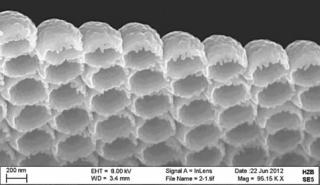May 14 2015
Converting solar energy and storing it in form of solar fuels, is one of the great scientific and technological challenges today to enable the transition into a more sustainable future powered by renewable energies.
Scientists at the HZB institute for Solar Fuels are exploring new semiconductor materials in order to develop compact, robust and economic solutions for “artificial photosynthesis”. They have submitted four research projects in collaboration with partners from universities for funding by the German Research Association (Deutsche Forschungsgemeinschaft DFG) in the Priority Programme „Fuels Produced Regeneratively Through Light-Driven Water Splitting” (SPP 1613). All four projects have now been approved for funding.
 At the HZB Institute for Solar Fuels, also nanostructures in metal oxides are explored as efficient catalyst materials for artificial photosynthesis. Credit: HZB
At the HZB Institute for Solar Fuels, also nanostructures in metal oxides are explored as efficient catalyst materials for artificial photosynthesis. Credit: HZB
“A success rate of 100 percent in this highly competitive call is truly remarkable, since only half of the submitted proposals could be funded”, Professor Roel van de Krol, head of the HZB Institute for Solar Fuels states. “This means we can further strengthen and expand our institute’s activities”. The first three projects are extensions of already running projects, while the 4th one is a new activity.
The objective is to investigate artificial photosynthesis based on solid-state inorganic materials from a fundamental scientific perspective as well as the aspects of material science required for its technological implementation. The goal is to convert solar energy into storable fuels, in this case hydrogen, which has a high gravimetric energy density and can be safely stored and used whenever needed, either in a fuel cell to generate electricity or as a base component for the production of synthetic hydrocarbon fuels.
The approved projects are:
- Development of catalysts, namely manganese oxides and molybdenum sulphides, for an implementation in a light-driven water-splitting device using a multi-junction solar cell. Partner: Prof. H. Dau (PI, FU-Berlin), Prof. P. Kurz (University Freiburg i. Br.), Prof. S. Fiechter (HZB).
- High-throughput characterization of multinary transition metal oxide and oxynitride libraries. New materials for solar water splitting with improved properties. Partner: Prof. Wolfgang Schuhmann (PI, Ruhr University Bochum), Prof. Alfred Ludwig (Ruhr University Bochum), Prof. S. Fiechter (HZB).
- Novel thin film composites and co-catalysts for visible light-induced water splitting. Partner: M. Behrens (Uni Duisburg), A. Fischer (Uni Freiburg), M. Lerch (TU Berlin), T. Schedel-Niedrig (HZB).
- Development of optimum bandgap photoanodes for tandem water-splitting cells based on doped complex metal oxides and III-V semiconductors coupled to water oxidation electrocatalysts. Partner: R. Beranek (PI, Ruhr University Bochum), A. Devi (Ruhr University Bochum), R. Eichberger (HZB).